
Argyll and Bute is one of 32 unitary council areas in Scotland and a lieutenancy area. The current lord-lieutenant for Argyll and Bute is Jane Margaret MacLeod. The administrative centre for the council area is in Lochgilphead at Kilmory Castle, a 19th-century Gothic Revival building and estate. The current council leader is Councillor Jim Lynch.

Dunoon is the main town on the Cowal Peninsula in the south of Argyll and Bute, west of Scotland. It is located on the western shore of the upper Firth of Clyde, to the south of the Holy Loch and to the north of Innellan. As well as forming part of the council area of Argyll and Bute, Dunoon also has its own community council. Dunoon was a burgh until 1976.
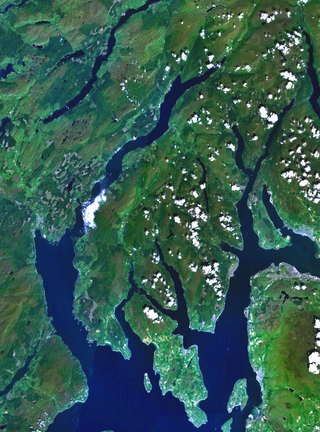
Cowal is a rugged peninsula in Argyll and Bute, on the west coast of Scotland. It is connected to the mainland to the north, and is bounded by Loch Fyne to the west, by Loch Long and the Firth of Clyde to the east, and by the Kyles of Bute to the south.

Loch Long is a body of water in the council area of Argyll and Bute, Scotland. The Sea Loch extends from the Firth of Clyde at its southwestern end. It measures approximately 20 miles in length, with a width of between one and two miles. The loch also has an arm, Loch Goil, on its western side.
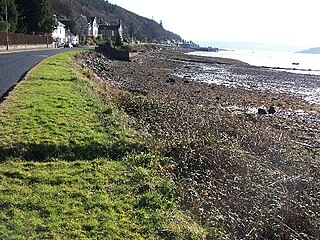
Kilmun is a linear settlement on the north shore of the Holy Loch, on the Cowal Peninsula in Argyll and Bute, Scottish Highlands. It takes its name from the 7th-century monastic community founded by an Irish monk, St Munn. The ruin of a 12th-century church still stands beside the Kilmun Parish Church and Argyll Mausoleum.
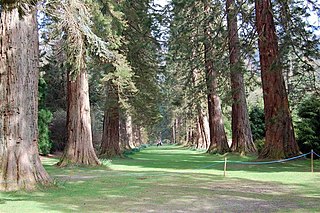
Benmore Botanic Garden is a large botanical garden situated in Strath Eachaig at the foot of Beinn Mhòr, on the Cowal Peninsula, in Argyll and Bute, west of Scotland. The gardens are on the west side of the A815 road from Dunoon, between the Holy Loch and Loch Eck, and include footbridges across the River Eachaig. It is one of the sites of Royal Botanic Garden Edinburgh.

Ardentinny is a small village on the western shore of Loch Long, 14 miles (23 km) north of Dunoon on the Cowal Peninsula, in Argyll and Bute, Scottish Highlands.

Glen Croe is a glen in the heart of the Arrochar Alps on the Cowal Peninsula, in Argyll and Bute, west of Scotland. The glen is surrounded by large and rugged mountains characterised by huge boulders. The Croe Water flows through the glen and into Loch Long.
Whistlefield is a hamlet on the east shore of Loch Eck on the Cowal Peninsula, in Argyll and Bute, West of Scotland. It is home to the Category C listed building, the Whistlefield Inn, which was established around 1801–1804. The hamlet is within the Argyll Forest Park, which is itself part of the Loch Lomond and The Trossachs National Park.

Strachur and Strathlachlan are united parishes located on the Cowal Peninsula, in Argyll and Bute, west of Scotland. Strachur is a small village on the eastern coast of Loch Fyne.
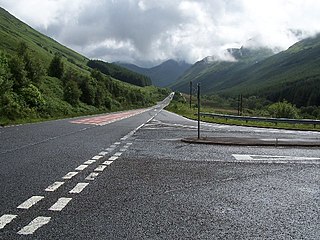
The A815 is a major road located on the Cowal peninsula, in Argyll and Bute, Scotland. It runs for about 35.7 miles (57.5 km) from the A83, near Cairndow, in the north to Toward in the south. It passes beside three lochs, while its final stretch is along the Firth of Clyde.

Beinn Mhòr is the highest mountain on the Cowal Peninsula, west of Loch Eck in Argyll and Bute, west of Scotland. It has a high topographic prominence to height ratio and consequently commands a good all round view.

Argyll Forest Park is a forest park located on the Cowal Peninsula in Argyll and Bute, Scottish Highlands. Established in 1935, it was the first forest park to be created in the United Kingdom. The park is managed by Forestry and Land Scotland, and covers 211 km2 in total.
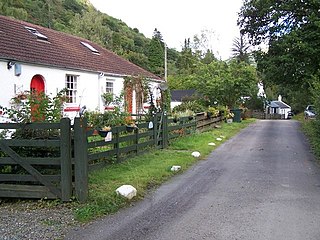
Glenbranter is a hamlet and former estate, once owned by Sir Harry Lauder, on the northwest shore of Loch Eck in the Argyll Forest Park, on the Cowal Peninsula, in Argyll and Bute, West of Scotland.
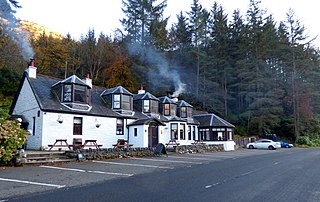
Coylet is a hamlet on Loch Eck, on the Cowal Peninsula, in Argyll and Bute, West of Scotland.
Rashfield is a hamlet on the Cowal Peninsula, situated between Loch Eck and the head of Holy Loch, in Argyll and Bute, West of Scotland. The hamlet is on the A815 road and the River Eachaig flows pass from Loch Eck to the Holy Loch. Rashfield is within the Argyll Forest Park which is itself within the Loch Lomond and The Trossachs National Park.
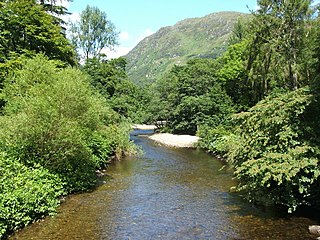
The River Eachaig is a river on the Cowal Peninsula, in Argyll and Bute, west of Scotland.

Puck's Glen is a river-formed ravine on the Cowal Peninsula, in Argyll and Bute, west of Scotland, with a popular scenic walking trail beside the Eas Mòr stream. In 2020 the glen and adjoining trails were closed temporarily due to COVID-19 restrictions, issues of stability of the gorge, and felling of trees infected by larch disease.

Glen Kinglas is a glen located on the Cowal Peninsula, in Argyll and Bute, west of Scotland. The glen is one of the main glens in the Arrochar Alps, the A83 road from Arrochar and Loch Lomond passes through the glen. At the north end of the glen, a pass leads to Glen Croe, passing Loch Restil. At the south of the glen the A815 road leaves the A83 and leads through the Cowal peninsula to Dunoon on the Firth of Clyde coast. The A83 continues on past Cairndow and Loch Fyne Oysters to Inveraray and Inveraray Castle on Loch Fyne.





















